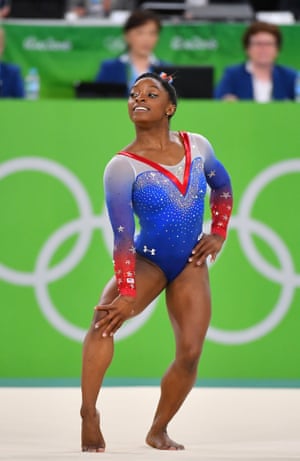The bikini is old-fashioned – no wonder it’s dying

The shortlist for outfit of summer 2016 runs something like this. Simone Biles in a leotard at the Rio Olympics, all stars and stripes and extra sparkle. Uma Thurman in a polo neck in the forthcoming Pirelli calendar. Taylor Swift on the beach with Tom Hiddleston, wearing lace-up brogues and a mustard-coloured sweater. Bella Hadid, naked but for two carefully positioned red roses, in the September issue of French Vogue.

Simone Bile at the Rio Olympics
Facebook Twitter Pinterest
Simone Bile at the Rio Olympics. Photograph: UPI/Barcroft Images
Notice what is missing: the bikini. For half a century, the iconography of summer and the bikini have been almost interchangeable. A bikini, a tan, a beach: that was what summer should look like. But the bikini is in decline. Retailers report a rise in sales for one-piece swimsuits – 30% year on year at Selfridges, 65% at online retailer Figleaves – while Victoria’s Secret are closing their “Swim” line, which was weighted towards skimpy bikinis, and plan to use the space in store to expand the athleisure offering.
Advertisment
Wholesale Shoe Hub Cheap Air Max Shoes Air Jordans Shoes Online
In the wake of the burkini controversy, it would be easy to pin the demise of the bikini as collateral damage in the culture war currently being fought on Europe’s beaches. That the burkini represents a level of threat such that it must be resisted with armed police reflects how the beliefs around women’s bodies for which this garment stands are, rightly or wrongly, perceived as a clear and present danger. But while it is temptingly neat to plot the bikini’s fall as a status symbol against the rise of modesty wear as a political issue, the reality is not that simple.
The problem is not that the bikini is too sexy for 2016. The problem is that the bikini represents a wholesome, respectable, entirely non-controversial level of sex appeal which simply no longer exists. This is not just about politics. It is about how the internet’s easy access to never-ending nudity rendered the bikini anachronistic: in the era of NSFW images, the sedate two-piece is losing its allure. And it is also about the escalation of hostilities in the field of body image, and how the very phrase “bikini body” has become controversial, representing an ideal we love to hate. The bikini triumphed for the second half of the 20th century because it represented an ideal of sex, summer, freedom and youth which was saucy enough to be compelling, but not fundamentally controversial.
To feel good in a bikini was an aspirational idea but – until the age of the photoshopped selfie and the Insta-model, when the body ideal became impossible – not an unrealistic or alienating concept. For all its flimsiness, the bikini stood for a consensus that is now under attack – and not from one enemy, but from all sides. The whole point of the bikini was that it was both gently provocative and entirely respectable, a line which it is increasingly difficult to walk.
In the era of NSFW images, the sedate two-piece is losing its allure
The rise of the burkini was foreshadowed by that of the kaftan. As the power-tanning of the 1980s and early 1990s hazed into the bohemian, health-conscious millennium and noughties, the kaftan was added to the packing pile. Awareness about the dangers of sun damage rose, the need to maximise the surface area of tanned skin fell away, and a whole new industry of “beach fashion” – cover-ups, tummy chains, gold tattoos – grew to fill a space once occupied by the need to get brown. Simultaneously, the rise of paparazzi click-bait created a new, confidence-battering image bank. If you weren’t haunted by the photos of actresses looking ridiculously gorgeous, you were haunted by the photos which proved even ridiculously gorgeous actresses sometimes look awful on the beach. Suddenly, women were wearing more clothes on the beach. The high-street kaftan unwittingly drove modesty creep on the beach long before the burkini, but thanks to its more easily mood-boardable aesthetic – 60s bohemian Marrakesh, rather than 21st-century Saudi – nobody noticed, or cared.

Margot Robbie on the cover of the Vogue June 2016 edition. Photograph: Vogue
Before its impact was felt on bikinis, modesty creep had all but taken out topless sunbathing, once the norm on many beaches in France, Spain and Italy. Part of this, ironically, is down to sartorial norms from elsewhere being imposed on the beaches of Europe – not from Islamic culture, but from the US, where topless sunbathing was never standard behaviour. Recent generations of European teenagers have taken their beach dressing cues not from their mothers and grandmothers, but from American pop culture, where the top stays on. When Kate Moss mentioned in an interview three years ago that she sunbathed topless – “I try to avoid a white boob” was how she phrased it, with impressive devotion to the fashion singular – it was reported as evidence of her rebellious nature.
There is a positive aspect to the triumph of the one-piece. That the new iconography of women’s bodies is about sport and fitness – and, as such, takes its aesthetic cues from the all-in-ones of the racing pool, the gymnast’s mat, or the dancer’s studio – is progress, surely, from the bikini’s none-too-subtle reference to the pairing of bra with knickers. But the bikini, in its pomp, represented fun and relaxation, semi-nudity without specific intent beyond that to read and doze and gossip and eat ice-creams. Who knew such simple pleasures would one day become so controversial?



/https%3A%2F%2Fassets.over-blog.com%2Ft%2Fcedistic%2Fcamera.png)
/https%3A%2F%2Fstorage.canalblog.com%2F65%2F68%2F1287460%2F119974884_o.jpg)
/http%3A%2F%2Fwww.theage.com.au%2Fcontent%2Fdam%2Fimages%2Fg%2Fq%2Fl%2Fp%2Fq%2Fo%2Fimage.related.articleLeadwide.620x349.gqlv7b.png%2F1470393037955.jpg)
/https%3A%2F%2Fstorage.canalblog.com%2F16%2F37%2F1287460%2F111908362_o.jpg)